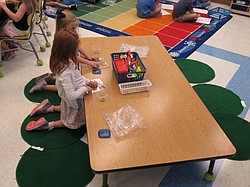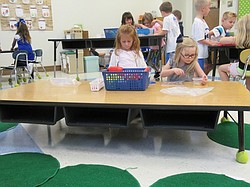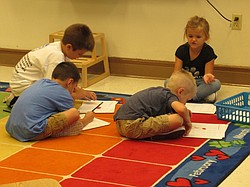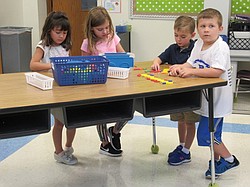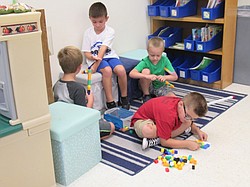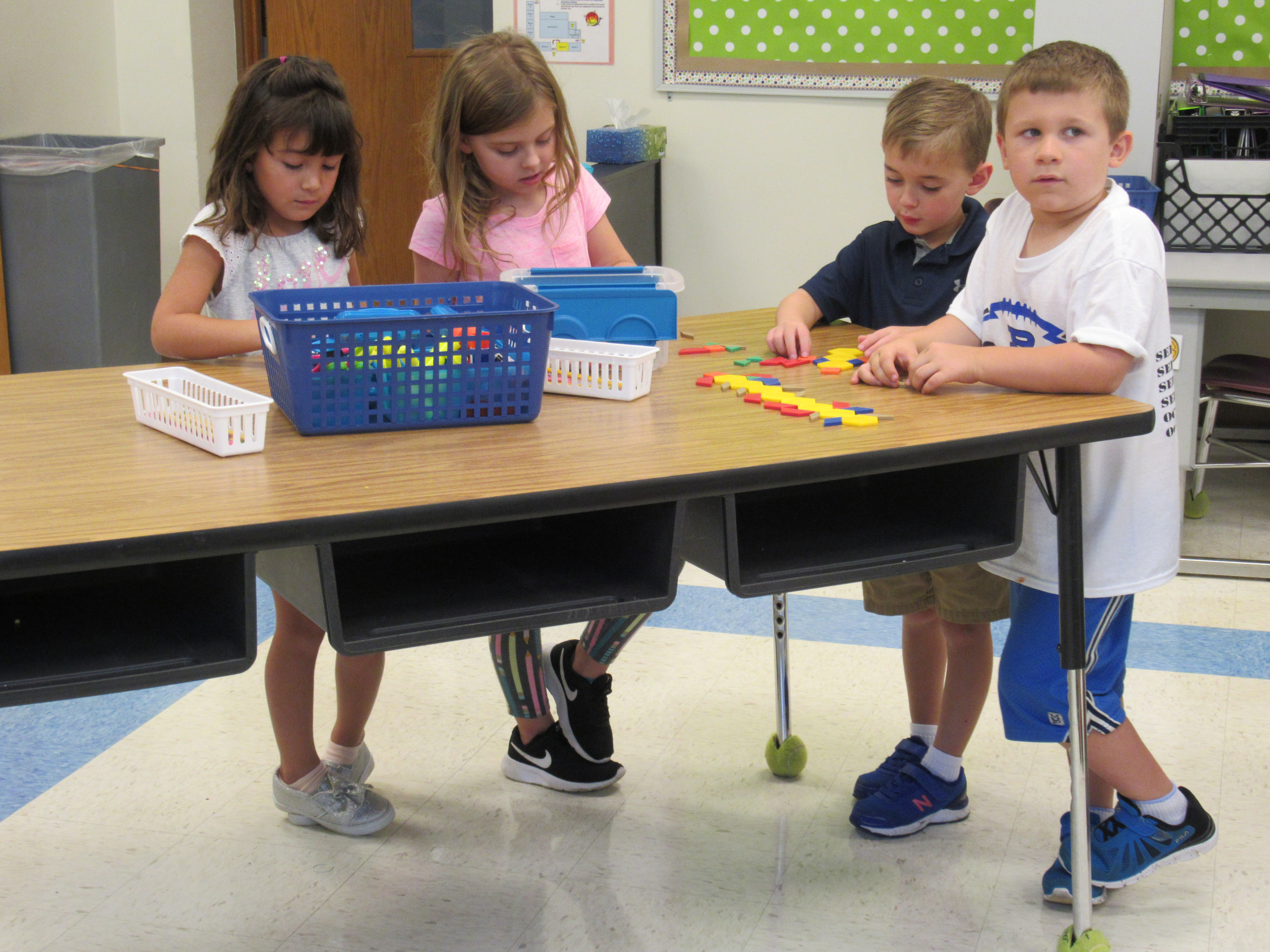
Neighbors | Jessica Harker.Students at Poland Union Elementary school in Kirsten Jacobs kindergarten classroom sat on carpet squares surrounding a table doing a math lesson Sept. 14.
Neighbors | Jessica Harker.Students in Kirsten Jacobs kindergarten classroom sat on carpet squares surrounding a table doing one activity of many set up around the room Sept. 14.
Neighbors | Jessica Harker.Students in Kirsten Jacobs kindergarten classroom sat on the carpet while working on math work sheets Sept. 14 at Poland Union Elementary school.
Neighbors | Jessica Harker.A group of students at Poland Union Elementary stand around a raised table in Kirsten Jacobs kindergarten classroom during their math lesson Sept. 14.
Neighbors | Jessica Harker.A group of boys stacked blocks Sept. 14 while sitting on the carpet in Kirsten Jacobs kindergarten classroom.
By JESSICA HARKER
Poland Union Elementary school is working towards incorporating 21st century learning ideas into their classrooms this year.
“I will tell you what I see, the kids in this building are blessed with 17 amazing teachers,” said Principal Mike Masucci.
Masucci said that this year he has noticed a number of classrooms begin trying out new methods to keep students engaged while learning.
“The role of a teacher has changed from being an educator to being an edu-tainer,” Masucci said. “If you in a lot of ways don’t manage your classroom by being an edu-tainer then you aren’t going to connect with these kids,”
Masucci said that in today’s age of growing technology it is changing the way students learn, therefore forcing a needed change the way they are taught.
“Good teachers are good teachers,” Masucci said. “But great teachers are able to be these edu-tainers, they are able to engage students.”
One way Masucci said that the school is adapting to this change is the integration of technology into the daily classroom.
The school has two sets of Chrome Books that students use daily, as well as a full time technology teacher.
“I really think that by the time these kids are out of the middle school years there will be no text books,” Masucci said.
Kindergartens go once a week to Nick Blanch, Poland’s technology teachers, to learn viable computer skills including how to type, identifying the parts of the key board and even learning how to e-mail their parents.
Masucci said that second-graders at the school use the Chrome Books every day for lessons.
“It’s the gift of this building I think,” Masucci said. “Kids are going into there and playing games, but learning computer and keyboard skills.”
The school began the technology program full time three years ago, according to Masucci, who said that the benefits have been keeping the school and the students engaged and up to date.
“It is necessary,” Masucci said.
Another way the school has integrated 21st century learning to the classroom is the use of flexible seating, and other similar changes to kindergarten classrooms.
Teacher Kirsten Jacobs said that she has been trying different types of unique seating options in her kindergarten classroom for years, but has seen a huge impact this year on how children interact with the work and each other.
“It looks a lot different from most of the rooms, its funny because the kindergartners don’t know, they don’t realize,” Jacobs said.
She explained that for her kindergarten room she has three tables set up, one high with no seats for standing, one set up regularly with chairs, and one set low surrounded by carpet squares for children to sit on the ground. Jacobs also has multiple carpeted areas where students can work on the floor around the room, she said, giving them flexibility in the environments to determine what works best for them.
“A lot of that is to give the kids a way to move a little bit. Just a sensory kind of thing in case they need it,” Jacobs said.
She explained that often times younger children are easily distracted because of a need for constant movement.
This classroom set up allows students to move, stand and get their energy out, while still being actively engaged in the task at hand.
“When I walk by her [Jacobs’] room, whether you see eight kids standing at a table or six kids sitting at a carpet square you can see that they are actively engaged in a lesson. Because when they are given the freedom to move about the room they are teaching themselves a lesson and Kristen becomes an observer guiding them,” Masucci said.
Jacobs said she is not the only teacher who does this, with many teachers in Poland and across the country integrating different seating such as yoga balls or wobble stools into their classrooms.
She also said that along with the flexible seating she has decided to do community supplies bins in her classroom this year, since students don’t have assigned seats so storing supplies becomes a challenge.
“Amazingly, they aren’t like ‘oh my gosh those are my pink scissors,’ they don’t care about that,” Jacobs said. “I think it gets them close to each other.”
She also allows students to choose, for each activity, where the group is going to be working.
Jacobs said that giving students these freedoms allows them an ability to problem solve and be more creative in what they do.
“At this age I want them to be comfortable with what they are doing here. I want to take away the need to move and wiggle, and focus on what they are doing,” Jacobs said.
The school year has only just started, Jacobs said, but already the changes made throughout the school seem to be effecting the students in a positive way.
“You have some people who may still think that in order to teach effectively the teacher has to be in front of the classroom smacking a ruler and the kids have to be in a straight line,” Masucci said. “But things are changing, students are changing, and we are changing with them.”
 43
43

